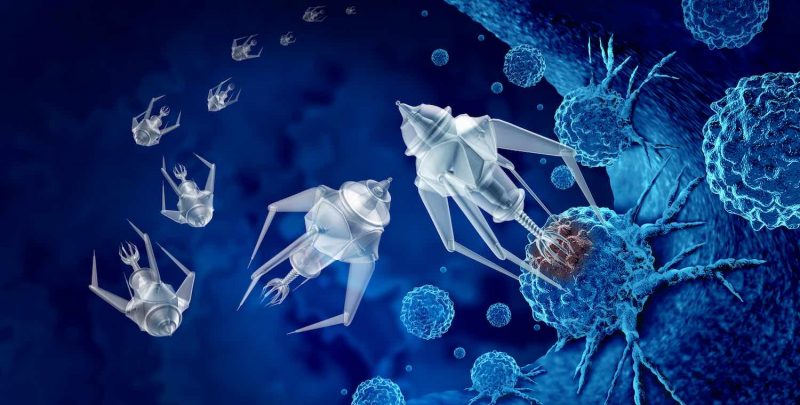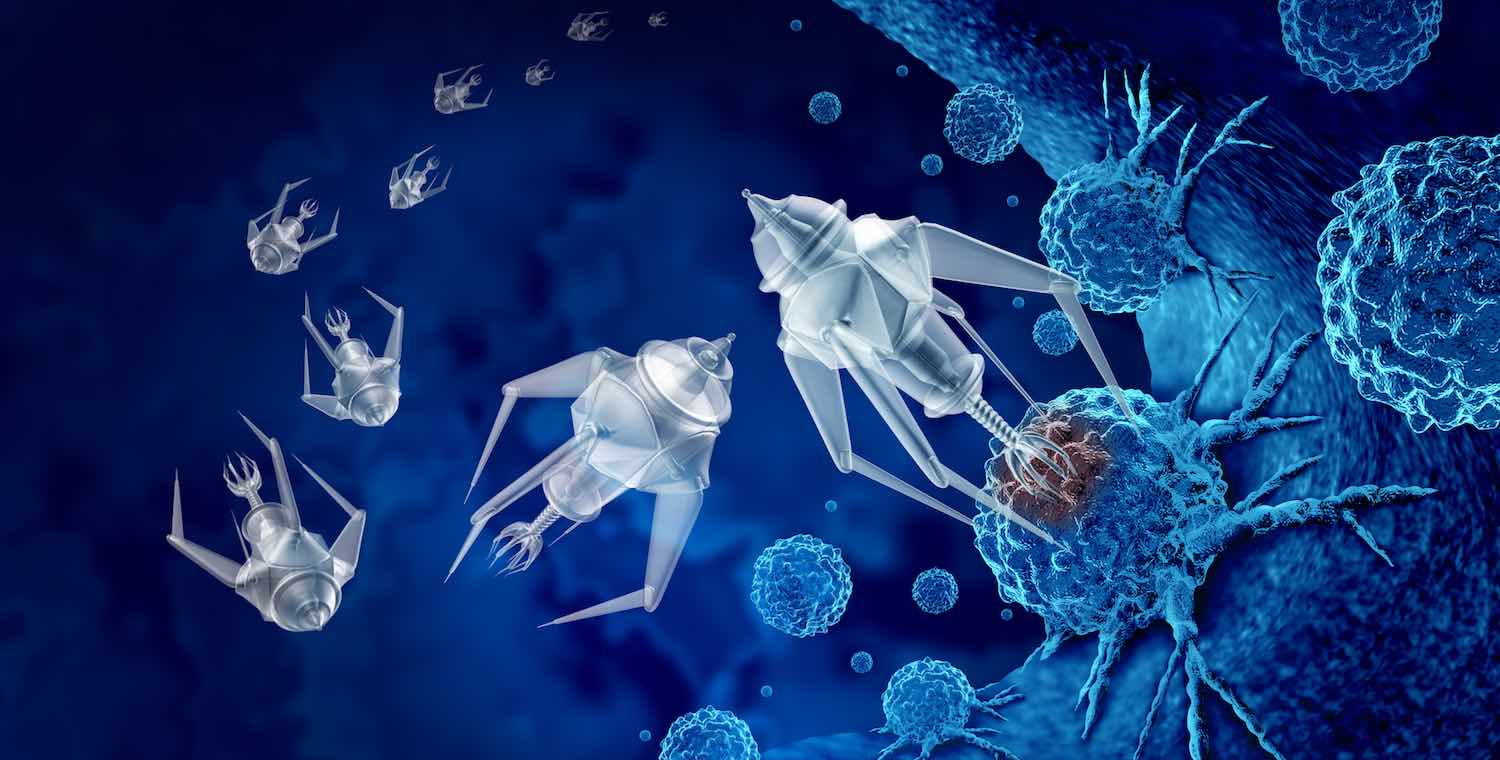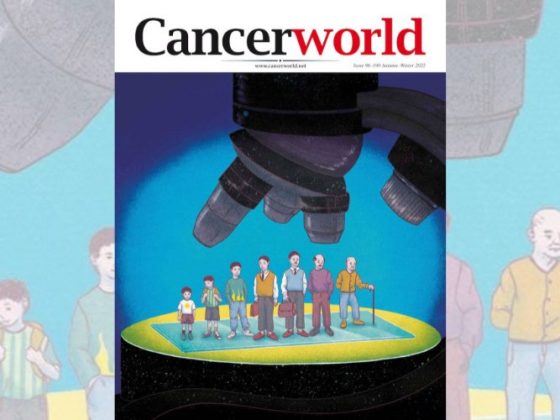A nanomedicine, as defined by the US National Institutes of Health, is a “highly specific medical intervention at the molecular scale for curing disease or repairing damaged tissues… ” For regulatory purposes, the term covers products with a size between 1 nm and 100 nm. At the bottom end of the scale (1 nm) this around 2.5 times smaller than the diameter of a strand of human DNA, around ten times smaller than the diameter of a protein and around 8,000 times smaller than a human blood cell (8 μm). At the higher end (100 nm), this is around ten times larger than the diameter of a protein, and is roughly equivalent to the size of a small virus.
Traditionally, cancer nanomedicines use their physical property of size to overcome some of the challenges associated with standard ways of delivering therapeutics. To do this, they use a variety of nanostructures, such as liposomes, lipid nanoparticles, micelles, gold nanoparticles or dendrimers to encapsulate or deliver drugs.
In cancer treatment, they have so far primarily been used to try to reduce toxicity and improve impact of chemotherapeutic drugs through better targeting. In future, their role could be greatly expanded to exploit the immunogenicity inherent in such tiny particles. Their impact could also be enhanced through greater personalisation, particularly using theragnostic techniques that can combine diagnostics with delivery of therapy – provided that researchers can find ways to overcome various outstanding hurdles.
Using size to passively target drugs on tumours
Historically, nanomedicine entered the field of cancer more than two decades ago, with the observation of the ‘enhanced permeability and retention’ effect, says Marina Dobrovolskaia, who leads the Nanotechnology Characterization Laboratory at the US National Institutes of Health. While traditional anti-cancer drugs spread throughout the body, hitting healthy and tumour cells alike, resulting in often serious and troublesome side effects, encapsulating the drugs within nanoparticles aimed to passively trap the therapy within the tumours, explains Dobrovolskaia. “Blood vessels of tumours grow very quickly and develop fenestrations, small holes. Nanoparticles could enter the tumour, but because of the high interstitial pressure and reduced lymphatic drainage, they would be stuck in the tumour and release the anti-cancer drug.”
In recent years, however, the importance of the ‘enhanced permeability and retention effect’ for nanomedicine has been challenged, says Dobrovolskaia. The idea that tumours are passively targeted by nanomedicines due to inherent physical differences between tumour cells and normal cells does not reflect the much more complex reality, which shows wide variations between patients in the way nanomedicines get distributed. Despite these uncertainties, nanomedicine has found entry into cancer treatment, driven by two main incentives: better control over side effects and, in some cases, better therapeutic outcomes.
Nanoformulations can increase the time a drug spends in the bloodstream and so its ability to accumulate in the tumour
“Traditionally, nanotherapeutics are developed to improve pharmacokinetics,” says Twan Lammers, head of the Department of Nanomedicine and Theragnostics at RWTH Aachen University Clinic, in Germany. By decreasing metabolism and excretion of a drug encapsulated in a nanostructure, nanoformulations can alter the half-life of a drug, increasing the time a drug spends in the bloodstream and so its ability to accumulate in the tumour.
Encapsulation in nanostructures can also reduce toxicity, for example hypersensitivity reactions to usual formulations of anti-cancer drugs. “Work is ongoing to increase activity and decrease non-desired effects,” says Juan Gonzalez-Valdivieso, a researcher at the Centre for the Cellular Microenvironment at the University of Glasgow, in Scotland. “For example, by encapsulating drugs, we can decrease the drug concentration needed… The advantage of nanomedicines is that it allows us to play with a wide range of different therapeutic molecules.”
What can oncology expect from nanotechnologies?
Around 15 nanomedicines are currently being used to treat patients with cancer, though the precise number varies depending on the criteria used. One such drug is doxorubicin liposomal – Doxil, or Caelyx in Europe – a polyethylene glycol (PEG)-liposome, measuring 100 nm in diameter, that contains doxorubicin. “One of the limitations of using doxorubicin was its cardiac toxicity,” explains Dobrovolskaia. “Placing doxorubicin in pegylated liposomes reduced cardiac toxicity.” At the same time, tumour cells are exposed to the chemotherapy for much longer using the drug in encapsulated form, as the half-life of Doxil is one hundred times that of free doxorubicin. Doxil was the first nano-drug to be approved by the US regulators, back in 1995, initially for use against AIDS-related Kaposi’s sarcoma. Today it is also used to treat ovarian cancer and multiple myeloma.
Another drug mentioned by Dobrovolskaia as a ‘posterchild’ for anti-cancer nanotherapy is nab-paclitaxel – Abraxane – a small albumin nanoparticle, around 130 nm in diameter, that contains the taxane paclitaxel, and was approved in 2005 initially for the treatment of metastatic breast cancer. In this instance, the nanotechnology is used not for passive targeting of tumour cells, but as an alternative to the emulsifier – Cremophor EL, a polyoxyl-ethylated castor oil – which is used to improve the solubility of paclitaxel within the body, but provokes hypersensitivity reactions in some patients.
As Lammers points out, once inside the patient, the nab-paclitaxel immediately disassembles, transferring paclitaxel to endogenous albumin in the blood stream, “so it doesn’t really use nanotechnology in the patient anymore.” But he agrees that it is nonetheless a good example of what the technology can deliver. “You can give Abraxane in 30 minutes, rather than three to four hours, and you can give 30–35% more of the drug – that’s a lot of added value, even though, from a technological point of view, the nano-formulation isn’t stable,” he says.
Other currently used nanotherapeutics in cancer include pegylated proteins, which increase solubility, prevent clearance by the kidney, increase circulation time and decrease immunogenicity. A good example is PEG-L-asparaginase – Oncaspar – approved in 2006 for the treatment of acute lymphoblastic leukaemia.
One question frequently posed of the nanomedicine field is: why are we still citing the anti-cancer nanotechnologies approved 15 years ago? Why haven’t more nanotechnological solutions reached the clinic yet, especially given that nanoparticles are frequently described in the literature as potential therapies?
One reason Lammers proposes lies in people’s perceptions: not all solutions that contain nanotech are badged that way. “People typically don’t call them nanomedicines. They call them liposomes or dendrimers. Prescription sheets usually don’t contain the word nano. Large pharma is very different from academics, who I think oversell the nano-aspect. Whereas for patients and industry, they don’t care whether it is a nanoparticle or not, as long as it works and is well tolerated.”
His own research group uses nanotechnology for imaging. “Our goal is not to make a nanoparticle, but to make a formulation or pharmaceutical product work better. There is a lot of overpromising, where [academic researchers] make nanoparticles that can’t be pharmaceutically upscaled. This overpromising is a problem.”
“Nanomedicine is just given to everybody in a non-stratified manner, and that is not good enough anymore against current standard-of-care”
He adds, however, that there may also be real factors at play. One such is the route of administration: while many new cancer therapies, such as tyrosine kinase inhibitors, can be given orally, nanoparticles need to be given intravenously. “Oral administration makes patients’ lives easier and the necessity of having to give nanomedicine intravenously is certainly not ideal.”
Then there is the issue of personalisation, which has been largely neglected in the development of these technologies, he says. “In nanomedicine, there has been a failure to figure out patient stratification, but most new anti-cancer drugs are based on patient stratification. Nanomedicine is just given to everybody in a non-stratified manner, and that is not good enough anymore against current standard-of-care, which is based on stratification.”
While biomarkers, such as receptor overexpression in a tumour, are readily available when considering treatment with antibodies, to help identify the subset of patients likely to respond, no equivalent has yet been developed for nanomedicines. When nano-formulations are not targeted to a specific receptor, imaging techniques can be used to assess whether, in a given patient, the nanomedicine is likely to reach its target. Several protocols, for example based on MRI or PET imaging, are being tested to see whether the enhanced permeability and retention effect is high in a given patient.
A related problem is how little we still understand about the way nanomedicines interact with the body, adds Lammers, which will be key to understanding who is most likely to respond – and when. The distribution of nanoparticles within the female reproductive system, for instance, is now known to vary dramatically according to the stage of the patient’s menstrual cycle, which needs to be factored in to optimise their delivery.
Yet, while those observations are undoubtedly valid at this time in the specific field of cancer, the progress nanomedicine is making at a clinical level should be judged by its wider performance, argues Sangeeta N. Bhatia, Director of the Marble Center for Cancer Nanomedicine, in a recent Nature Reviews Cancer article.
“The Covid-19 pandemic has taught us that long-standing investments in nanoparticle technology were well worth it”
When new treatment modalities emerge, she argues, “we never judge the impact of the modality based on the timescale of regulatory approvals in a single disease area, such as cancer.” What happens is that the technology is invested in, and the results are evaluated across different disease areas. By that standard, argues Bhatia, nanomedicines have certainly proved themselves. “If nothing else, the Covid-19 pandemic has taught us that long-standing investments in nanoparticle technology were well worth it. […] Without nanotechnology, in my opinion, we would be in a very different public health situation today.”
Dobrovolskaia agrees wholeheartedly that the mRNA vaccines owe their success to nanotechnology and cancer medicine. “After 20 years of active research in this area, we now have a better idea what methods we need for nanoparticle characterisation, and whether to use liposomes or the gold nanoparticles or another nanocarrier to formulate a drug. We have a very good foundation of basic research and particle characterisation research that is very supportive for the next generation of nanomedicines,” she says.
New directions
Targeting and personalisation
This next generation of cancer nanomedicines may well look beyond reducing side effects and increasing concentrations. The specificity of nanomedicines may be increased using active targeting, says Gonzalez-Valdivieso. “We are trying to personalise nanomedicines by attaching different targeting proteins to the nanomedicine’s surface, so that it is able to travel through the body until it is able to recognise the cancer cells and attack them.” This would improve the selectivity of the drug and decrease distribution to healthy tissues. Taking advantage of the different characteristics of tumour cells, “we can tailor our system to suppress or cultivate different epitopes in the surface. If we are able to design a system that is able to be internalised in all the cancer cells, that would be awesome.” In that regard, future nano-formulations may be similar to antibody drug conjugates, which use biotechnology to target tumours by binding to a specific tumour antigen and attacking the cell with the conjugated drug.
Different active substances could be encapsulated in targeted nano-formulations and, combined with controlled release, this could create highly targeted anti-tumour effects. External triggers, such as light or ultrasound, would trigger release of the active substance only at the tumour site.
Immunotherapies
Lammers believes that mRNA vaccines is where the modality may truly prove its worth in fighting cancer, arguing that this setting is “using nanotechnology to the max”. He envisages injecting patients intravenously with nanoparticles encasing mRNA that encodes for patient-specific tumour neoantigens. This strategy would take advantage of the fact that nanoparticles are quickly flagged by the immune system with the result that they accumulate in the spleen. That’s not desirable when the intention is to focus accumulation within tumours, but it’s perfect when you want to target the immune system, ensuring the antigen-presenting cells in the spleen are well-exposed to the nanoparticles’ mRNA payload. This could help trigger anti-tumour responses, turning a current drawback of nanomedicines – off-target redistribution – to an advantage. “[This is] where nanotechnology enables significant advances, rather than just suppressing or shifting side effects,” says Lammers.
This could help trigger anti-tumour responses, turning a current drawback – off-target redistribution – to an advantage
As Dobrovolskaia notes, this strategy exploits another characteristic of nanoparticles, which contributed to the success of the mRNA-based Covid-19 vaccines: their adjuvanticity. “The lipid nanoparticle mRNA vaccines didn’t use adjuvants… Now we know that lipid nanoparticles provide adjuvanticity, so nanocarriers have intrinsic adjuvant properties,” she says. This inherent property could allow future nano-medicines to improve the efficacy of immunotherapy. “A lot of research is using nanoparticles, either to deliver immunomodulatory agents or use nanocarriers for their immunomodulatory properties, to change the tumour microenvironment and make immunotherapeutics work better.”
“Other strategies are to combine nanomedicines with CAR-T cells to train the immune system both with the lymphocytes and the nanoparticles at the same time,” adds Gonzalez-Valdivieso. As CAR-T cells work well for some patients with blood malignancies, but not in patients with solid tumours, nanoparticles may be used to more robustly activate T cells prior to transfer into the patient. T-cell-stimulating agents could also be encapsulated within nanoparticles to co-stimulate the immune system or even pre-treat the tumour microenvironment, making it less immunosuppressive.
Early detection, diagnostics, imaging
In future, nanoparticles could also find more use in cancer detection. For ex vivo diagnostic tests, nanotech-materials could be used to increase sensitivity and specificity, Lammers writes in Nature Reviews Cancer, and enable the detection of very low concentrations of cells, proteins or nucleic acids. He also expects nanotechnology to improve the detection of extracellular vesicles from biopsies, which could be an additional diagnostic tool. By contrast, he says, the technology is generally not ideally suited to in vivo diagnostics. “What makes nanoparticles good for therapeutic purposes is that they don’t clear very quickly from the body. They stay in the bloodstream, over time deposit in the tumour – more or less efficiently. If we think about diagnostic agents, they are the direct opposite: They need to be very small, they need to be cleared very quickly, with very rapid contrast.”
One option that Gonzalez-Valdivieso highlights would be to combine diagnostics and therapeutics in a single nanoparticle. “With one injection, we could see where the tumour is and treat it.” Such ‘theragnostics’ could find application in the diagnostic pathway, at the point when a tumour is strongly suspected, he explains. “Especially for fast-growing tumours, everything you can do to treat the tumour earlier, you increase the chances to survive.”
When it comes to imaging tumours, Lammers adds, nanoparticles cannot generally compete with MRI, PET scans or CT, not least because they accumulate in tumours with high variability, which may lead to false negatives. But they could have advantages in certain settings.
One application currently under preclinical investigation is for use in intraoperative detection of tumour margins in close to real-time. In this instance, gold nanoparticles would be used to allow for the delineation of the tumour using Raman spectroscopy – a technique that determines vibrational modes of molecules, which could be implemented with a hand-held scanner.
Ferumoxtran nanoparticles have also shown promising results for detecting lymph node metastases in prostate cancer patients, while nanoscale 99mTc-labelled sulphur and albumin colloids are used to localise sentinel lymph nodes.
This extraordinary diversity of ways in which nanotechnologies could be employed to tackle cancer goes a long way to explain the point Lammers makes about their lack of public recognition. This is not just a complex drug product, it is a science that can use materials, design and engineering to carry out all manner of tasks, or assist in their execution, at the physiological level where cancer – and the immune system – do their business.
And as Lammers points out, much of this is done largely under the radar. Who among the hundreds of millions of people receiving mRNA anti-Covid vaccines knew that they had nanotechnology to thank for the vaccine remaining intact on its journey to their cells? There are good reasons for optimism about what nanotechnologies will be able to contribute to efforts to detect, diagnose and treat cancer over the coming years. But we may have to look hard to spot their growing role.













1 comment
Nanotechnology is steadily expanding its role in tackling cancer through targeted drug delivery, enhanced imaging, and early detection methods. These advancements promise more effective treatments and improved outcomes for cancer patients, marking a significant shift in oncological therapies.
Comments are closed.